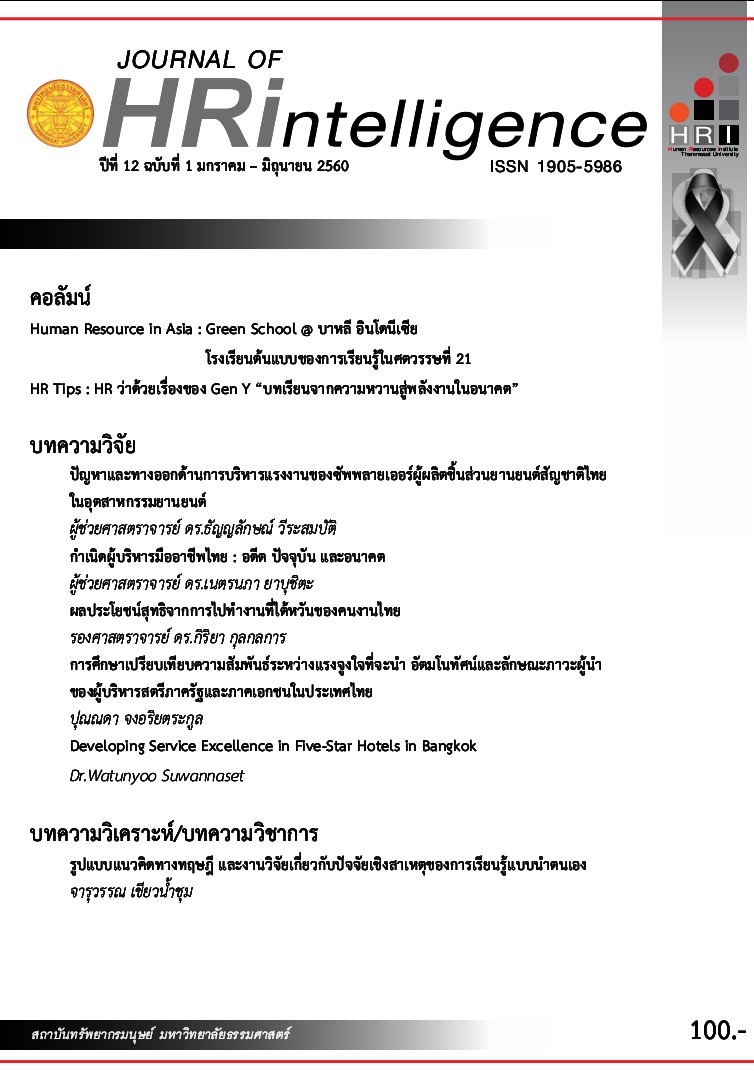Problems and Solutions for Labor Management in Thai Automobile Suppliers
Main Article Content
Abstract
This research aims to analyze the labor management problems facing Thai auto parts suppliers as well as to propose some possible solutions. The research was conducted by gathering data and information through interviewing 31 suppliers’ representatives and government agencies as well as a survey of 425 workers. Employing content and thematic analyses, the research has key findings as follows. The Thai auto suppliers have labor management problems in two stages: employment and management. For employment, there are shortages both in terms of quantity and quality. This study investigates 4 aspects of labor management within the workplaces. First, on recruitment and selection, four problems are outstanding, namely quitting, discontinuity in skill development, high labor expenditures, and delayed government procedures regarding the employment of legal migrant labor. Second, on the compensation system, there is no significant problem. Yet, it was found that welfare is not sufficiently provided to labor. Third, on skill development, there is a tendency that workers quit the job after having been trained and that Thai workers do not really desire skill development. Fourth, on labor relations, there is virtually no problem, as these suppliers tend to use kinship-like organization culture. Workers’ reaction on the four aspects of labor management are at moderate level.Considering each aspect, workers tended to agree with skill development the most, compared to the rest aspects which are at moderate level rated in the following order: compensation, then labor relations, while recruitment and selection came last.
This research proposes suggestions for firms and the government. For firms, employing migrant labor and adopting technology are suggested to solve the labor shortage problem. Meanwhile, the emphasis on OJT is suggested to solve the labor quality problem. Regarding labor management problems, firms must add innovation in managing their employees, particularly on compensation management that could motivate workers to continue working and minimize quitting rate. The government must have a clear, consistent, and integrative labor policy, particularly on the transition toward electric automobiles as the transition will create unemployment due to the termination of some suppliers such as suppliers doing business in automobile exhaust system. The government should also emphasize more on dual system training as it helps graduates to have ready skill needed to work. Regarding migrant labor, it is suggestible as a short-term measure that the government develop their skills to increase efficiency, while the Thai labor are yet to cope with new technology which suppliers are also slow to adopt or adjust themselves.
Article Details
ขอมอบลิขสิทธิ์บทความที่ได้รับการตีพิมพ์ให้แก่สถาบันเสริมศึกษาและทรัพยากรมนุษย์ กรณีมีการฟ้องร้องเรื่องการละเมิดลิขสิทธิ์เกี่ยวกับภาพ กราฟ ข้อความส่วนใดส่วนหนึ่ง และ/หรือข้อคิดเห็นที่ปรากฎในบทความ ให้เป็นความรับผิดชอบของข้าพเจ้าและผู้เขียนร่วมแต่เพียงผู้เดียว
References
จารุพร มณฑาพงศ์. (2553). ปัจจัยที่มีความสัมพันธ์กับการเข้าเป็นสมาชิกสหภาพแรงงาน บริษัทผลิตชิ้นส่วนยานยนต์แห่งหนึ่งในนิคมอุตสาหกรรมอีสเทิร์นซีบอร์ด(ระยอง). (วิทยานิพนธ์ปริญญามหาบัณฑิต). มหาวิทยาลัยบูรพา, คณะการจัดการและการท่องเที่ยว, สาขาการจัดการทรัพยากรมนุษย์.
ธัญญลักษณ์ วีระสมบัติ. (2560). ปัญหาและทางออกด้านการบริหารแรงงานของซัพพลายเออร์ไทยในอุตสาหกรรมยานยนต์. โครงการ ASEAN watch สำนักงานกองทุนสนับสนุนการวิจัย (สกว).
นิตย์ จันทรมังคละศรี และคณะ. (2538). ยุทธศาสตร์การพัฒนากำลังคนทางเทคโนโลยีเพื่อพัฒนาเศรษฐกิจและความสามารถในการแข่งขัน. รายงานฉบับสมบูรณ์. กรุงเทพฯ : สถาบันวิจัยเพื่อการพัฒนาประเทศไทย, ฝ่ายวิจัยการพัฒนาวิทยาศาสตร์และเทคโนโลยี.
พีระ เจริญพร. (มีนาคม 2553). การแสวงหาผลประโยชน์จากการเป็นซัพพลายเออร์ของบริษัทข้ามชาติ : กรณีศึกษาอุตสาหกรรมชิ้นส่วนยานยนต์ไทย. วารสารเศรษฐศาสตร์ธรรมศาสตร์, 28 (1) : 35-83.
พงศ์พันธ์ ตั้งกิจ. (2549). การศึกษาสภาพปัญหาการพัฒนาฝีมือแรงงานในสถานประกอบการผลิต.ชิ้นส่วนยานยนต์ (วิทยานิพนธ์ปริญญามหาบัณฑิต) มหาวิทยาลัยเทคโนโลยี, คณะครุศาสตร์อุตสาหกรรมและเทคโนโลยี, พระจอมเกล้าธนบุรีสาขาวิชาวิศวกรรมอุตสาหการ.
ภัทรพงศ์ อินทรกำเนิด, และ เกรียงไกร เตชกานนท์. (2558). Intra industry trade,Product Fragmentation and Technological Capability Development in Thai Automotive Industry. สืบค้นเมื่อวันที่ 10 มีนาคม 2558 จาก, http://www.eria.org/ERIA-DP-2015-10.pdf
วิระศักดิ์ สาระรัตน์ และคณะ. (2548). โครงการสำรวจข้อมูลฝีมือแรงงานในอุตสาหกรรมยานยนต์. กรุงเทพฯ: สำนักงานปลัดกระทรวงแรงงาน.
ศุภชาญ อรัญสวรรค์. (2542). ความพึงพอใจในสวัสดิการของพนักงานในโรงงานอุตสาหกรรมผลิตชิ้นส่วนยานยนต์. กรุงเทพฯ :มหาวิทยาลัยเกษตรศาสตร์.
สถาบันยานยนต์. (2555). แผนแม่บทอุตสาหกรรมยานยนต์ปี2555-2559. กรุงเทพฯ : ผู้แต่ง.
สถาบันยานยนต์. (2557). ข้อมูลผู้ผลิตชิ้นส่วนยานยนต์ปี2557. กรุงเทพฯ : ผู้แต่ง. (เอกสารอัดสำเนา).
สภาอุตสาหกรรมแห่งประเทศไทย. (2559). ปี2558 ผลิตรถยนต์1,913,002 คัน ต่ำกว่าเป้าแต่เพิ่มขึ้นจากปีที่แล้ว ร้อยละ 1.76 ขายในประเทศ799,592 คัน ตามเป้า ส่งออก1,204,895 คัน ตามเป้า. สืบค้นเมื่อวันที่ 22 สิงหาคม 2559, จาก http://www.acarnewsonline.com/carbusiness/tficarreport.
สิทธิพร เจริญสิทธิกุล. (2546). แรงงานสัมพันธ์ขององค์กรธุรกิจในวิสาหกิจขนาดใหญ่ที่มีสหภาพแรงงาน ศึกษากรณีบริษัท ไทยฮอนด้า เมนูเฟคเจอริ่ง จำกัด. (วิทยานิพนธ์ปริญญามหาบัณฑิต). มหาวิทยาลัยบูรพา, บัณฑิตวิทยาลัย สาขาการจัดการทรัพยากรมนุษย์.
สมชาย หาญหิรัญ. (2557). แนวโน้มอุตสาหกรรมยานยนต์และชิ้นส่วนยานยนต์ในปี2557-2560. เอกสารการประชุม สำนักงานเศรษฐกิจอุตสาหกรรม กระทรวงอุตสาหกรรม.
สุจิตราภรณ์ คำสอาด. (2540). การส่งเสริมการพัฒนาทักษะแรงงานในสถานประกอบการขนาดกลาง. (วิทยานิพนธ์ปริญญามหาบัณฑิต). มหาวิทยาลัยธรรมศาสตร์, คณะสังคมสงเคราะห์ศาสตร์, หลักสูตรพัฒนาแรงงานและสวัสดิการ
มหาบัณฑิต.
ศุภชาญ อรัญสวรรค์. (2542). ความพึงพอใจในสวัสดิการของพนักงานในโรงงานอุตสาหกรรมผลิตชิ้นส่วนยานยนต์. กรุงเทพฯ :มหาวิทยาลัยเกษตรศาสตร์.
อาชนัน เกาะไพบูลย์. (2552). Global Integration of Thai Automotive Industry. กรุงเทพฯ : มหาวิทยาลัยธรรมศาสตร์,คณะเศรษฐศาสตร์.
อุษณีย์ เหมแหวน. (2543). ความรู้สึกมั่นคงในการทำงานของพนักงานบริษัทในเขตอุตสาหกรรมสยามอีสเทิร์น : ศึกษากรณีบริษัทผลิตชิ้นส่วนยานยนต์. (วิทยานิพนธ์ปริญญามหาบัณฑิต). มหาวิทยาลัยมหิดล, บัณฑิตวิทยาลัย, สาขาวิชาประชากรศึกษา.
Thammavit Terdudomtham. (1997). The Automobile Industry in Thailand. Bangkok: Thailand Development Research Institute.
World Motor Vehicle Production. (2015). 2015 Production Statistics. สืบค้นเมื่อวันที่ 22 สิงหาคม 2559, จาก http://www.oica.net/category/production-statistics/


